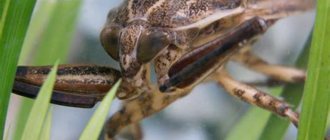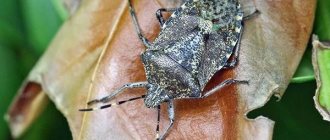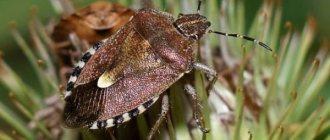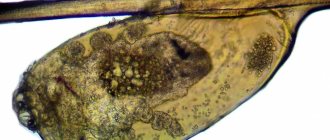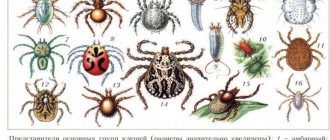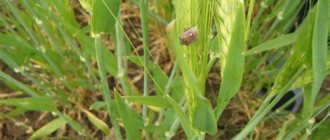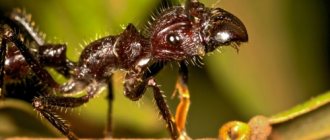Taxonomy of the species and description
Water striders are invisible on the water, they do not drown, and they have every opportunity to move quickly. The senses and vision help to navigate the surrounding space; the paws do not sink, which is explained by their structure. This insect is found both in natural and artificial reservoirs.
| Squad | Hemiptera |
| Suborder | Bedbugs |
| Infrasquad | Water striders |
| Superfamily | Garroidea |
| Family | Water striders |
Population and species status
No one specifically undertakes to destroy water striders, because they cannot cause significant harm. In addition, individuals reproduce quite quickly, which allows them to constantly increase their numbers. This made it possible to assign this group of insects the status of “not causing concern.” Accordingly, there are no negative factors affecting the water strider.
Water striders often move surrounded by other individuals
Appearance of a water strider. Distinctive features of the structure
Such individuals have a number of characteristics that unite all bedbugs:
- 1 pair of antennae - they are sensitive, thanks to them the large water strider orients itself, finds food and fellow creatures in the environment;
- 3 pairs of limbs, and they are very thin and quite long, the last 2 pairs differ in significant size;
The front legs are short - they help the insect to develop significant speed
- there are organs of vision, but this does not reduce the importance of the function of the antennae, which act as organs of smell and touch;
- the oral apparatus is not very powerful, but still it helps to obtain food (piercing-sucking type), and the proboscis is quite long.
Insect running on water
Signs that allow you to distinguish the water strider from representatives of other types of bugs:
- on the limbs there are many hairs of short length, upon a quick examination they are invisible, it seems that the legs are smooth, but upon closer examination you can see the fleecy surface of the limbs, this feature allows insects to stay on the surface of the reservoir;
- there are wings, the front pair is leathery, hard, and the back pair is transparent;
- body sizes vary: from 5 to 30 mm, which depends on the type of insect;
- looks inconspicuous, because the body color is most often brown, dark green;
- The body shape is oval, the body is narrow, due to its small size the insect stays on the water surface for a long time and does not drown.
The oval oblong shape of the body and three pairs of legs distinguish the water strider from a spider
If you don't know that it's a bug, you might mistake a water strider for a spider. The similarity would be striking if not for one difference - thin-legged fish have only 4 limbs that move along the surface of the water (the front pair of legs is designed to secure the victim and increase the speed of movement).
Photo gallery: water striders in their natural habitat
Natural habitat of water striders
Water strider habitat
The water bug sucks out the nutritious juice of the victim with its proboscis
Appearance and features
Photo: Water strider insect
The water strider is a predatory insect, the dimensions of which depend on the species. Most of the species of these animals have a small body size - only a few millimeters in length. However, many water strider bugs are large in size for an insect. Some species can reach a length of seventeen millimeters. The color of the body also largely depends on the species. It ranges from greenish to dark brown. The lower part of the abdomen and legs of the insect are covered with stiff bristles. It has water-repellent properties. The abdomen is usually brown or gray in color.
Insects have a small head, against which the proboscis and antennae stand out. Antennae are an important part of the water strider's body. They help the animal to detect various odors and serve for the sense of touch. The proboscis takes part in hunting. With its help, the bug injects a special enzyme into its victim. This enzyme dissolves the insides of prey.
Particular attention of people in the appearance of water bugs is always attracted by the legs. They look frighteningly long. Water striders have three pairs of legs, each of which is endowed with its own functional abilities. The first two legs (the shortest) are used during hunting to capture prey, the middle and rear pairs are necessary for support and movement. The bristles located on the legs retain air, which makes the insect “unsinkable”. Some adult species also have wings. With their help, water striders fly over various distances to search for food.
Interesting fact: Lake and river water bugs do not have wings. They simply don't need them. The species of water striders that live in puddles need them most. With the help of their wings, these insects can move, because puddles dry up sooner or later.
Features and habitat of the water strider
These insects are found literally everywhere. Some species live even in Siberia; low temperatures suit them. Representatives of such groups live in cold springs and feel very cheerful; they do not try to find new places to live. Water striders are found in different types of reservoirs:
- seas;
- rivers;
- keys;
- lakes;
- swamps;
- swimming pools
- puddles.
Those individuals that live on the surface breathe air constantly; it enters the body through the respiratory system (stigmas on the abdomen, meso- and metathorax). For example, sea insects need to swim to the surface to get some air. Features of life activity are determined by the type of water strider. For example, there are individuals that live mainly near the shore; they do not run far. Others, on the contrary, can move significant distances.
Water striders are insects that prefer company. They always spend time on the surface of the water together with their relatives.
The water strider's two pairs of limbs differ in significant size.
There are up to 6 individuals nearby at a time.
Such representatives of the animal world (according to taxonomy, they belong to the animal kingdom) survive winter. But at the same time they are not active, but go into the diapause phase. Water striders do not remain on the surface of the water, nor do they sink to the bottom. Where then do such individuals spend the winter period: they go out onto land, here they settle down under moss, stones, between the roots of trees, which allows them to hide from the cold and wind. Moreover, these individuals do not go far. They choose wintering shelters on the coastal strip.
Types of water striders in Russia
One of the most common is pond water.
The water strider bug from this group of individuals stands out from the rest of its fellows with black stripes on its thighs. Their middle limbs are longer than the first and last ones. Found in nature, but not everywhere. Habitat: eastern part of Russia, as well as Siberia, Asia, Africa. Insects have brown outer coverings. The limbs are covered with hairs, thanks to which the surface of the water has become the same covering for thin-legged bugs as the ground is for land bugs.
Individuals have a body up to 15 mm, less often – up to 17 mm. Shape – elongated, oval. They have wings, with their help the thin legs escape from danger. In addition, long legs help water striders jump. Moreover, they do this unexpectedly; a person may be frightened by such actions of a “chip” floating on the surface. There are large eyes on the head, but the insect also orients itself thanks to its sensitive antennae. Such individuals return from wintering in early spring, and at the first slightly more significant drop in temperature than usual in summer, the water strider bugs fly away.
They settle down for the winter in protected places, for example, in barns.
The pond water strider has wings, with their help they escape from danger
Big
Representatives of this group are slightly larger than the previously considered species; their body length is 17 mm. The shade of the outer integument is lighter - the body appears red. At the same time, it is also covered with micro hairs. This feature distinguishes all water striders that live on the surface of the water. It is the hairs on the underside of the body that contribute to the external changes of the insect. The water strider appears to be silver in color.
The ability to hold on without the risk of immersion in water is ensured by wax components on the limbs.
When the insect begins to move, gliding is visible, creating the effect of moving on ice on skates or measuring the length of a reservoir with special instruments, which contributed to the appearance of this name. When a water strider escapes from danger (underwater pests), it can make jumps. She behaves exactly the same way when an obstacle appears on the water: a snag, a stick or a leaf.
Representatives of this species are distinguished by the ability to reproduce throughout the summer period.
The Great Water Strider is the most common species in Russia
Pantsirnaya
Often found in nature, but in a certain area. This species typically lives in the eastern part of Russia. The water strider is medium in size, the body is small - up to 11.5 mm. The color of the outer integument is quite dark – brown. According to other characteristics, individuals do not stand out against the background of representatives of other varieties. The bedbug's legs move naturally through the water.
It is distinguished by large organs of vision and long antennae.
The armored water strider is distinguished by large visual organs
Velia
These are representatives of a special group - the family Veliidae (water striders). Such individuals are often found in the northern regions of Russia. They chose rushing streams and springs. The strength of the current does not prevent individuals from existing in such bodies of water. This is partly due to the high speed of movement. The body color is black, but on top you can see a brown tint, as well as a specific pattern. The mid- and metanotum are segmented. The types of limbs of this bug are different: short and thicker.
It is interesting that representatives of this species were previously terrestrial, but now they have adapted to life on the water. Such individuals barely reach 9 mm, and some species are much smaller - 2 mm. There are 670 varieties of Velia water meters. Such individuals have one feature - the absence of wings in many insects. Only rare species can boast the ability to fly. Often such individuals are called water crickets. They have a heavier (wide) body. The proboscis is multi-segmented, long, but in a calm state it is almost invisible - it is pressed against the chest.
There are many short hairs on the insect's body. They are so densely located that they will not allow water to penetrate deep.
Photo of a special group of water striders - Velia
In addition, the hairs are covered with a waxy substance, due to which a silvery tint appears (light is refracted, reflected from the water, and falls on the outer integument of the water striders). Such individuals prefer to get out onto land before the onset of cold weather. They look for areas covered with moss and climb under stones. The main feature of representatives of the Velia family is the unpleasant odor that they emit (as with individuals living on land) if they sense danger.
Because of this, natural enemies (mainly fish) do not eat such bugs.
Rod-shaped
These are larger individuals. The maximum body length is 22 mm. There are about 120 species of such individuals, but all 2 species have so far been found in Europe. Such insects live not only on water, but also on land, and can climb onto floating leaves. They prefer to choose a plant substrate as a wintering shelter. Such individuals lived many millions of years BC. Their remains are found in fossils left over from those times.
Such individuals lived many millions of years BC. Their remains are found in fossils left over from those times. One of the species of this group is the common water strider. Its body is narrow, long (13 mm), color is dark gray, almost black. The limbs of such bugs are even thinner than those of other species; they only touch the water at the end. Insects literally walk on the surface of the water surface. Their thin long antennae resemble 4 pairs of legs. Such individuals do not have wings.
Interestingly, rod-shaped water striders are destroyed by representatives of other species of this group of insects, as well as spiders.
Threats to stick-shaped water striders include other species of the water bug family and spiders
Movement of water striders on water
Water striders are real virtuosos of gliding along the surface of the water. They are able to use their long legs to run through the water, like speed skaters on smooth ice.
Having encountered an obstacle - a strip of duckweed or other aquatic plants, the “skaters” make deft leaps and overcome the obstacle with strong leaps. The main participation in such maneuvers belongs to the two rear pairs of legs. The water strider's legs are covered with a fatty substance and are not wetted by water, so the insect easily glides along the surface of the water. In addition, during movement, tiny turbulences appear in the water before the next stroke of the limbs. These mini-whirlpools help the water strider move across the surface without any effort, whether in a calm pond or in a restless ocean.
Scientists have proven that water striders of all sizes use their limbs like oars, rowing and transferring momentum to the water mainly through dipole vortices created by their legs. To test this assumption, the researchers created an artificial insect that could move like a water strider. In English, a water strider is “water strider” or “walking on water.” The robot was called a “robostrider,” and the artificial water strider was able to move through the water like its natural counterpart.
When moving, the water strider spreads its legs wide, evenly distributing its body weight over a large area.
The long, narrow body of the water strider, with sharp and fast movements, perfectly cuts through the air.
The structural features of the legs are also associated with the movements of insects through water: the thin legs of the water strider at the junction with the body are extremely thick, there are strong muscles that are involved in strong movements.
A water strider cannot drown, even if it is deliberately lowered into the water.
The ventral side of the body is covered with white hairs with a waxy substance, so water does not wet the body and legs of the water strider.
The fact is that air bubbles are held between the smallest hairs. And since the weight of the insect is small, this air prevents the water strider from drowning.
Life cycle, water strider reproduction
The method of laying eggs depends on the type of bug. Most large individuals leave eggs on plants growing in water. There are many of them, but all round formations are connected to each other by the mucous secretions of the female. For comparison, small insects make small clutches - leaving one egg at a time. Moreover, they do not cover their offspring with mucus.
There are up to 50 eggs in total. They are small, not exceeding 1 mm. Formations are white. Insects do not choose special places for mating. Reproduction occurs directly in the water. Moreover, male water striders are more attentive to their partners and offspring.
They show care - they provide protection from encroachments from other males.
Larva
The shade of the outer integument is yellowish. The insects, while still very small, are very different from the mature thin-legged insects:
- body no more than 1-1.5 mm;
- the limbs are not thin enough and not so long;
- abdomen shorter, swollen.
Young individuals develop on average in 2-4 weeks. The rate of their formation is influenced by environmental conditions. In hotter climates, insects go through all phases of maturation faster.
Photo of a water bug larva
Adults
The lifespan of adult bedbugs is 1 year (average). But often the period of existence is prolonged if the water measuring insect ends up in an area with a cooler climate. When the larvae become adults, they acquire the ability to reproduce. They begin to lay eggs on plants growing in rivers and lakes.
Reproduction and lifespan
The female water strider lays eggs on the leaves of plants, attaching them with the help of special mucus (in appearance it resembles a long cord consisting of deposits of several dozen eggs). If a clutch of many testicles is made, then a mucous substance is not required.
And for small clutches you can’t do without it, because the eggs simply won’t be able to stay in the soft tissues of plants. Males are distinguished by their “paternal instinct”; after fertilizing females, they actively participate in their lives, even accompanying them during the period of laying eggs. They protect and protect the female and cubs.
Important! All summer days, sexually mature individuals reproduce. The larvae appear in a couple of weeks, and within a month they become adults. Young ones can be distinguished from their parents by the body size of the water strider and the short, swollen abdomen of the cubs. The lifespan of water striders is about a year.
Danger and benefit for humans
An insect water meter can disrupt the integrity of the integument of insects and even fish fry. Despite the fact that it has a piercing-sucking type of mouthparts, such a bug is capable of biting a person. But this will not be severe damage to the epidermis in the full sense. A bug bite in this case is an ordinary puncture. But at the time of insertion of the proboscis, unpleasant sensations may appear.
The bite itself poses no threat to humans. Even the risk of developing allergies is low.
Serious consequences do not appear. Bedbugs bite in self-defense if they feel threatened. They bring many benefits - they clean the pond of dead insects, and also help control the number of horseflies.
Water striders are not dangerous to people
Features of behavior of water striders
Many people mistakenly assume that this is an exclusively aquatic insect. The water strider indeed spends most of its life in the pond, but this does not mean that it is not capable of conquering other elements. For example, she has wings that allow her to make short flights. She uses them if her native reservoir begins to dry up and she needs to find a new shelter.
These bugs can also crawl on the ground. They do this very ineptly, since their thin legs constantly get stuck in small cracks and breaks. However, despite this, land is vital for them. The thing is that water striders cannot spend the winter in water, and therefore look for a warm home in the ground or in a tree. Thus, this type of bedbug is truly unique, because it managed to conquer three elements at once.
What do water striders eat?
The water strider has a long, quite powerful, but at the same time thin proboscis. It can bend when there is no need for food.
Many other insects provide food sources. Bedbugs eat mosquitoes, flies, horseflies and other individuals that fly too low or fall into the water. If we study the question of what the water strider eats, we must not forget about the underwater inhabitants. Such bugs also find fry of fish and jellyfish nutritious. The diet of sea, river and marsh thin-legged individuals is somewhat different.
The water strider insect's bite is deadly to smaller creatures. This is due to the fact that bedbugs of this species have external digestion. First, they inject into their victim a special secret that helps change the structure of the tissues; they turn into a liquid substance. Water bugs suck out this nutritious juice.
This type of insect also eats the eggs of other pests, such as mosquitoes, which also helps humans.
Water strider hunting: video
Question-answer section
To understand whether the water strider is harmful and how to avoid meeting it, since it can bite, you need to study the features of the lifestyle of such an insect. If you have additional questions, you can ask a specialist on the website. All information will be provided by entomologist Irina Igorevna Petrova, work experience – 24 years.
Is it necessary to fight water striders?
Petrova Irina Igorevna
Entomologist with 24 years of experience
Ask a Question
“There is no need to specifically destroy such insects. For the most part, they are not dangerous; on the contrary, they are beneficial, because... help reduce the number of harmful individuals (for example, horse flies). However, some representatives can also kill rare species of fish (they feed on the juice of fry). In this case, an entire population of marine inhabitants could be at risk.”
Do water strider bugs fly and do they have wings?
Petrova Irina Igorevna
Entomologist with 24 years of experience
Ask a Question
“The body structure of different species is different. Most have wings. Accordingly, many spiny bugs can fly. They do not always move in this way, but use it when they plan to go for the winter or, conversely, emerge from diapause, look for new habitats on the water, and also for the purpose of protection from underwater predators.”
Interesting facts from the life of water striders
The insects have a small body; what makes these bugs large are their long limbs. Other features:
- The water strider beetle moves quickly, which makes it a good hunter, but pests still have to compete for the right to get the best share of food, the most dexterous one gets it - the one who manages to grab the victim and run away with it to a secluded place, the rest of the fighters can still time to attack each other, because they do not notice the loss;
- bugs of this group always move in a southerly direction, there is no exact data explaining this behavior, it is assumed that they are oriented by the sun;
- The water strider beetle can feed on live and dead insects.
The water bug is a good hunter due to its exceptional movement speed
Description of the insect
Water strider larvae have greater mass than adults with shorter legs. The bodies are light brown or green. They feed on small insects that inhabit the shores of reservoirs, and do not allow larvae and eggs to pass through.
The larval stage lasts about a month with the passage of 5 stages of development and ends with molting. The abdomen, gathered into folds, straightens out after being filled with food.
Adults began to be called water striders because of their ability to glide along the surface of the water. From the outside it seems that they are tirelessly measuring the area of their possessions. Their bodies and paws are covered with waterproof pile. 3 pairs of legs provide high speed of movement and capture of prey. The front pair of short legs is used to hold prey, and they also regulate the speed and direction of movement. The remaining legs provide reliable support and stability on the water. During sharp turns, the water strider, working with the legs of the sides in opposite directions, can turn 180 degrees in place . If necessary, easily jumps over obstacles encountered on the water.
The water bug (the second name of the water strider) can grow up to 3 cm. The protective color is dark brown with a brown tint. This allows it to be unnoticeable to birds and fish.
The bug uses its long antennae located on its small head as an organ of touch, feeling objects it encounters. Ball-shaped eyes provide a wide viewing angle and good vision. But the bug receives the bulk of information from water fluctuations. Bedbugs use their existing wings only for migration from one body of water to another, since movement on land is difficult for them.
Natural enemies of water striders
All sources of danger for such bedbugs are in their habitat – water. Here these insects are happily hunted by fish and frogs of various species. In each of the reservoirs there is at least 1 natural enemy of insects, or even more.
Another dangerous pest is the water mite. The thin-legged fish is often attacked by its offspring.
Parasites of water striders
Smaller individuals also bite such insects - these are the pests Gerris rufoscutellatus. They attack thin-legged creatures and drink their blood. Some of the parasites are so small that from the outside they can be mistaken for red dots (we are talking about Limnochares parasites).
The sphagnum bug is found only in some countries
Reviews from people
Anna, 31 years old, Perm
I saw a water strider on vacation, there were a lot of them on the river. I have known these insects since childhood, I know them well, so I am not afraid. But my daughter got scared when she saw how they began to jump, and some even flew.
Marina, 34 years old, Rostov-on-Don
I was once bitten by a water strider. Who would have thought such a harmless creature. It was unpleasant, but everything went away almost immediately. There are no traces left.
Svetlana, 27 years old, Chelyabinsk
I saw water striders land on the water - it happens quickly. I felt uneasy, but I am glad that these insects do not attack people (I read their description).
Water striders are insects that prefer company
Features of reproduction
Fertilization of the female by the male occurs on water. After 7 days, eggs are laid on aquatic plants , placing them along the edges of the leaves. The number of eggs in a clutch can reach up to 50. Love games begin with the onset of warm days. The next breeding cycle occurs in mid-summer. At this time, water striders of different ages coexist peacefully in the reservoir.
The laying of eggs by the female occurs under the protection of the male. During this period, he ensures the safety and peace of the female, constantly patrolling the surrounding area. When a rival appears, the male warns him of the seriousness of his intentions by beating his paws on the water. He recognizes the “gait” of his chosen one from afar and never attacks her.
Water striders spend the winter on the banks of the reservoir. Having found a suitable place in the bark of trees or in cracks in the ground, they sleep until spring . First, they shed their wings, becoming land dwellers.
Expert opinion
Marinina Evgeniya Vitalievna, research fellow, work experience – 16 years:
Marinina Evgenia Vitalievna
Entomologist, researcher. Work experience 16 years.
Ask a Question
• to understand why water striders do not drown, it is necessary to remember about surface tension, and bugs are also kept on the water thanks to the many micro hairs and wax impregnation on the limbs; • insects are interesting for their active position: they win food for themselves, quickly elude natural enemies, can fly and quickly jump over obstacles; • in reservoirs, bugs come from the coastal strip in the spring - they settle nearby, seek shelter in the form of moss and roots growing on the surface, but they are difficult to detect due to their dark, inconspicuous color.

